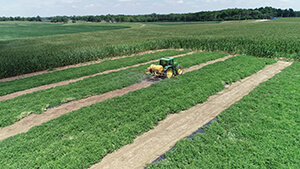
The vast majority of farmers use chemical insecticides to protect their crops against potentially damaging insect pests. This should not be a foreign concept to beekeepers; the majority of beekeepers use miticides to protect their bees against the varroa mite.
But how farmers use insecticides varies greatly. Some farmers operate on a schedule, applying insecticides every month or so to prevent pest problems from occurring. When insecticides are cheap and pests are a consistent threat, this can be an effective strategy.*
Conversely, some farmers use Integrated Pest Management (IPM) to decide when to use insecticides. A cornerstone of IPM is monitoring for pests and only using insecticides when pest populations or damage from those pests reaches a predetermined economic threshold. In this way, insecticides are only used when necessary, which saves money and reduces unnecessary pesticide inputs to the environment. To continue with the varroa analogy, if you monitor for varroa levels in your colonies and only treat with miticides when levels are above a predetermined threshold, you are practicing IPM.
When a crop relies on insects for pollination, another potentially important economic benefit of IPM exists. By using fewer insecticides, insect pollinators are less likely to be harmed, which could translate into better pollination, improved crop yield, and greater economic returns for a farmer.
This all sounds good in theory, but is there real-world evidence that practicing IPM and using fewer insecticides can improve yield in a pollination-dependent crop? If so, is increased yield due to greater numbers of bee pollinators? And what about a crop that doesn’t rely on pollinators? Can farmers improve their bottom line by taking an IPM approach, or will they frequently surpass economic thresholds such that impacts on yield occur? These are the topics for our forty-ninth Notes from the Lab, where we summarize “IPM reduces insecticide applications by 95% while maintaining or enhancing crop yields through wild pollinator conservation,” written by Jacob Pecenka and colleagues and published in the Proceedings of the National Academy of Sciences [2021].
For their study, Pecenka and colleagues focused on one pollination-dependent crop (watermelon) and one crop that doesn’t require insect pollination (corn). They wanted their study to mimic what a farmer would experience in the field, so they set up large field-scale plots of watermelon and corn at five sites across Indiana (Photo 1). The sites were positioned along a latitudinal gradient with at least 100 km separating one another, ensuring a diversity of climatic conditions, soil types, and local pest pressures.
At each site, one watermelon and one corn plot were conventionally managed (CM), and an identical set of plots were managed using Integrated Pest Management (IPM). Farmer surveys were conducted before the experiment and the CM plots were managed in the way that most farmers currently manage their fields. For watermelon, this included a soil drench of the neonicotinoid insecticide imidacloprid (Wrangler at 814.09 mL/ha) and four sprays of the pyrethroid insecticide lambda-cyhalothrin (Warrior II at 140.3 mL/ha) at 4, 6, 8, and 10 weeks post-transplant. For corn, seed was treated with the neonicotinoid thiamethoxam (Cruiser 5FS at 1.25 mg a.i. per seed). Conversely, the IPM watermelon and corn plots only used insecticides when pests reached a predetermined economic threshold, which rarely occurred (Figure 1).
All plots were supplemented with a honey bee and bumble bee colony (Photo 2) and bee visitation at watermelon flowers was recorded weekly during bloom. At the watermelon plots, plants were surveyed for pests for a 10-week period that extended into harvest, at which time mature fruits from each plot were counted, weighed, and inspected for marketability using USDA grading standards. At the corn plots, early- and late-season crop damage were assessed, and yield was determined by subsampling the plots. Finally, pesticide residues in soils, crop leaves, and crop pollen were measured using liquid chromatography and mass spectrometry (HPLC-MS/MS).
So, what did they find? Did pesticides need to be used in the IPM watermelon or corn plots? As seen in Figure 1, pest pressure was greater in IPM vs. CM watermelon plots in all three years. However, the economic threshold of five striped cucumber beetles per plant (red lines in Figure 1) was only ….


